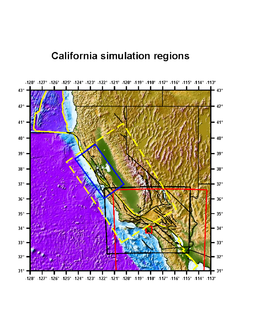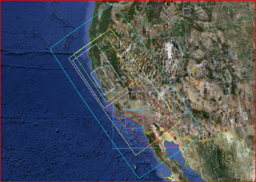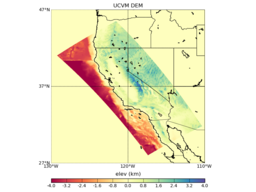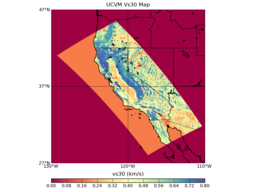Difference between revisions of "UCVM Users Guide"
| Line 119: | Line 119: | ||
The following is a proposed coverage region and projection. The entire state of California is included, along with portions of Oregon, Nevada, Arizona, and northern Mexico.[[File:UCVM_Coverage_Region.png|256px|thumb|right|Proposed coverage region for UCVM (cyan) overlayed upon regions of various California 3D velocity models (CVM-S: red, CVM-H: blue, LinThurber: yellow, Thurber NoCal: green, USGS Bay Area: white)]] | The following is a proposed coverage region and projection. The entire state of California is included, along with portions of Oregon, Nevada, Arizona, and northern Mexico.[[File:UCVM_Coverage_Region.png|256px|thumb|right|Proposed coverage region for UCVM (cyan) overlayed upon regions of various California 3D velocity models (CVM-S: red, CVM-H: blue, LinThurber: yellow, Thurber NoCal: green, USGS Bay Area: white)]] | ||
<pre> | <pre> | ||
| − | Origin: -129. | + | Origin: -129.75 DD, 40.75 DD |
Projection: Azimuthal Equidistant (lon_0=-120.0, lat_0=36.0, x_0=0, y_0=0) | Projection: Azimuthal Equidistant (lon_0=-120.0, lat_0=36.0, x_0=0, y_0=0) | ||
Rotation Angle: 55.0 D | Rotation Angle: 55.0 D | ||
| − | Dimensions: 1800km x | + | Dimensions: 1800km x 900km |
</pre> | </pre> | ||
Revision as of 23:21, 17 May 2011
Unified California Velocity Model (UCVM) is a proposed California state-wide 3D velocity model. One important use of UCVM is in high resolution 3D wave propagation simulations for California. UCVM development is an interdisciplinary research collaboration involving geoscientists and computer scientists. UCVM geoscience research includes identification and assembly of existing California velocity models into a state-wide model and improvements to existing velocity models. UCVM computer science research includes definition of a easy-to-use CVM query interface, integration of regional 3D and geotechnical models, and automated CVM evaluation processing capabilities.
Contents
Existing Model Coverage
UCVM is trying to move forward on a statewide seismic velocity model for CA suitable for ground-motion modeling. Current concept is that this model would not be a single model but a seamless combination of models covering various regions of the state. The tricky part of course is the transition from one model to another and the use of background models to fill in the gaps.
As a first step, we want to put together a map of the coverage:
Current Detailed Seismic Velocity Models
- SCEC CVM-4 CVM-S
- SCEC CVM-H CVM-H
- USGS Bay Area Model cencalvm
- Carl Tape's Great Central Valley Model
- Rob Graves' Cape Mendocino Region Model, Graves (1994)
Background Tomographic Models
- Moschetti Surface Wave Models
- Parkfield regional model, Thurber et al (2006)
- San Francisco area regional model, Thurber et al (2007)
- Northern California Regional 3D P-wave Velocity Model, Thurber et al (2009)
- Egill's regional southern CA model
- California Statewide 3D Velocity Model, Lin et al (2010). wiki: Lin Thurber CVM website: Guoqing Lin's website
Summary of Coverage Regions
Tape is working on a new socal mesh (black) of CVMH6.3 will cover somewhat west and north of the current CVMH model. This is the m16 model region from my thesis, which was based on an older CVMH model. Eventually it will contain the entire CVMH6.3 model, including to the south. All CVMH6.3 simulations are Vp, Vs, rho, with constant attenuation above the basement surface (in the basins). CVMH goes down a couple hundred kms, but the portion I use is upper 60 km, and the local earthquake inversion sensitivity is dominantly upper 25 km.
- The yellow dashed line is the target simulation goal for San Joaquin and Sierra model and simulations. Andreas, John, and Carl have developed several surfaces within this region (including to the continental shelf), and we have lots of velocity data in the San Joaquin basin, which is our focus. (Andreas loaded the Lin-Thurber CA model as well.)
- The red box is CVMH6.3
- The inner red box as the high-res LA model.
- California CVM regions CVM Boundaries in KML format
Model List
SCEC CVM-S
This southern California model is described at CVM-S.
SCEC CVM-H
This southern California model is described at CVM-H.
USGS Bay Area (cencalvm)
This northern California model is described at cencalvm.
Northern California Regional 3D P-wave Velocity Model
Here is info on the first of four of our regional-scale 3D P-wave velocity models that I will provide. This is for our Northern California model, published in Thurber et al (2009).
Formally, the bounding rectangle is approximately given below however, the western edge realistically is the California coastline, and the northern edge is not quite to the Oregon border.
42.60, -122.32 40.34, -126.27 37.74, -117.88 35.62, -121.71
- The bottom nodes of the model are at 36 km.
- Node spacing is mostly 10 or 15 km in the NE-SW direction and is uniformly 20 km in the NW-SE direction. Actual model resolution based on checkerboard tests is nominally ~twice the node spacing.
- Vp model provided.
Cape Mendocino Region Model
This manuscript describes some 3D modeling of the Eel River basin which is in the Cape Mendocino region at the northern end of the San Andreas. Rob Graves did this work as part of the development of the 3D FD methodology and published as a USGS external grant report in Graves (1994).
Parkfield Regional Model
Parkfield regional model, published in Thurber et al. (2006). Bounding box corners:
TOP: 35.918339 -121.412085 36.6838908 -120.320581 BOTTOM: 35.0996582 -120.542912 35.86521 -119.45284
The model is fully documented in the supplementary information for the paper Thurber et al (2006).
San Francisco Regional Model
A higher-resolution model for the San Francisco Bay area, published in Thurber et al (2007). It covers a smaller region than our northern California model so perhaps it is not useful.
Desired Model Features
There is a set of fundamental information necessary to include any new model into UCVM, regardless of delivery format (files, table in a paper ,etc.). If the new model is already packaged as a downloadable code set, there are a number of features that make it easier for it to be integrated into UCVM. These are listed below.
Fundamental Information
- The map projection/datum used, and the (lon,lat) to (x,y) transformation
- The bounding polygon for each models
- The depth extent, and whether the model is query by depth/elevation/elev_offset
- Brief description of the resolution
- The physical properties it includes (i.e., density, Vp, Vs, Qp, Qs).
Packaging in Code
- Provide both application programming interface and command-line query tool
- Programming interface: C preferred, although C++/Fortran will work, with the following function defined:
- Initialization function
- Query model function
- Get Version ID function
- Finalizer (cleanup) function
- GTL toggle: Allow toggling any GTL on/off in both API and command-line tool
- Allow query by (lon, lat, depth), where depth is offset from free surface, positive down
- Return Vp, Vs, density at a minimum
- Model region has finite extents, outside of which the query function returns a "no data" indicator
- Able to compile model with generic GNU compiler
Prototype UCVM API
A prototype API for a state-wide model has been developed and is described in this document: UCVM API.
Coverage Region and Projection
The following is a proposed coverage region and projection. The entire state of California is included, along with portions of Oregon, Nevada, Arizona, and northern Mexico.
Origin: -129.75 DD, 40.75 DD Projection: Azimuthal Equidistant (lon_0=-120.0, lat_0=36.0, x_0=0, y_0=0) Rotation Angle: 55.0 D Dimensions: 1800km x 900km
- UCVM regions UCVM Boundaries in KML format
- Extremes of UCERF 2.0 ruptures we would like to include (kml)
Statewide DEM
A statewide DEM for the proposed coverage region is included within UCVM. Elevation data has been sampled from USGS NED 1 arcsec dataset (~30 m), and bathymetric data from the NOAA ETOPO1 1' dataset (~1.5 km). For testing purposes, this DEM is currently sampled at a resolution of 1km but this resolution can be easily increased. The elevation at a particular point is smoothed using bilinear interpolation of the surrounding four elevation points.
Statewide Hydrology Map
A statewide hydrology map for the proposed coverage region will be included within UCVM. This map will provide the surface elevations of bodies of water such as oceans, lakes, and seas. No source dataset has been identified as of yet. This map will allow water information to be returned when UCVM is queried by elevation.
Statewide Vs30 Map
A statewide Vs30 map for the proposed coverage region is included within UCVM. Vs30 data for the California landmass has been sampled from the Wills (2006) dataset at approx 0.0002197 D resolution, and out-of-state/ocean areas have been sampled from the Wald (2007) dataset at 0.0083333 D resolution. For testing purposes, this map is currently sampled at a resolution of 1km but this resolution can be easily increased. The Vs30 value at a particular point is smoothed using bilinear interpolation of the surrounding four map points.
Statewide Geotechnical Layer
A statewide GTL for the proposed coverage region is included within UCVM. This is based on the Vs30-derived GTL method developed by Ely (2010). Interpolation between this GTL and the underlying crustal models is accomplished with the interpolation method described in that same publication. The z range over which interpolation is performed is configurable, as is the interpolation method used. The Ely method takes its input Vs30 value from the Vs30 map included within UCVM (described in the previous section).
Additionally, UCVM is able to support any number of other user-defined GTLs. It will combine them in a manner analogous to how the crustal models are combined. Each GTL may also have its own user-defined interpolation function that is used to blend it with the underlying crustal models. If no interpolation method is specified, linear interpolation is assumed.
Combining Regional Models
The UCVM API currently combines models by simply tiling them in a user-specified order. If this method will continue to be used, then properly combining regional models into a statewide will require some smoothing/reconciliation of the overlaping regions. Smoothing will likely need to be performed manually on a case-by-case basis, to ensure that the best available data is for a particular region/basin is used. For example, we may need to produce a patch model that smooths the overlap between the CVM-S and USGS Bay Area models as shown below.
CenCal/CVM-S
A set of plots showing the interface betwen USGS CenCal and CVM-S from depths 0-20km can be downloaded here: tiling_cencal_cvms.tar
Visualization Tool
A simple web service for generating plots from UCVM is available at UCVM Viz (SCEC login required).
Related Entries
See Also
- Harvard Structural Geology & Earth Resources Group
- SCEC CVM
- Geoff Ely Vs30 geotechnical layer implementation
- Qinya Liu Tomography Research
- GuoQing Lin's Research
- USGS CVM Web Site
- Main Page
- SCEC Home Page
References
- Ely, G., T. H. Jordan, P. Small, P. J. Maechling (2010), A Vs30-derived Near-surface Seismic Velocity Model Abstract S51A-1907, presented at 2010 Fall Meeting, AGU, San Francisco, Calif., 13-17 Dec. [Ely2010-AGU.pdf]
- Graves, R. (1994), Rupture History and Strong Motion Modeling of the 1992 Cape Mendocino Earthquake, USGS External Grant Report
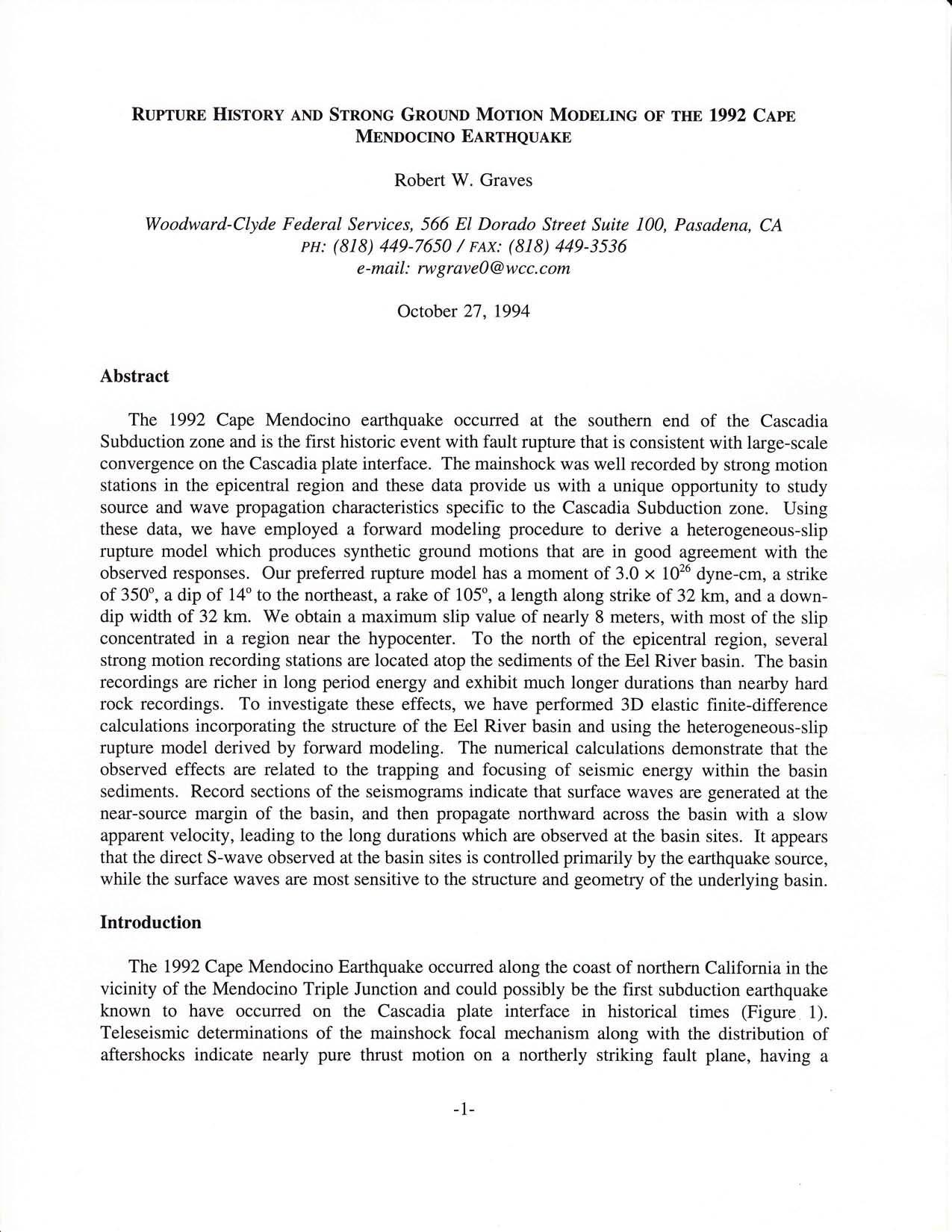
- Lin, G., C. H. Thurber, H. Zhang, E. Hauksson, P. Shearer, F. Waldhauser, T. M. Brocher, and J. Hardebeck (2010), A California statewide three-dimensional seismic velocity model from both absolute and differential Times, Bull. Seism. Soc. Am., 100, in press. supplemental
- Thurber, C., H. Zhang, F. Waldhauser, J. Hardebeck, A. Michael, and D. Eberhart-Phillips (2006), Three-dimensional compressional wavespeed model, earthquake relocations, and focal mechanisms for the Parkfield, California, region, Bull. Seism. Soc. Am., 96, S38-S49, 2006. supplemental
- Thurber, C., T. Brocher, H. Zhang, and V. Langenheim (2007), Three-dimensional P-wave velocity model for the San Francisco Bay region, California, J. Geophys. Res., 112, B07313, doi:10.1029/ 2006JB004682, 2007.
- Thurber, C., H. Zhang, T. Brocher, and V. Langenheim (2009), Regional three-dimensional seismic velocity model of the crust and uppermost mantle of northern California, J.Geophys. Res., 114, B01304, doi:10.1029/2008JB005766, 2009.
- Wald, D. J., and T. I. Allen (2007), Topographic slope as a proxy for seismic site conditions and amplification, Bull. Seism. Soc. Am., 97 (5), 1379-1395, doi:10.1785/0120060267.
- Wills, C. J., and K. B. Clahan (2006), Developing a map of geologically defined site-condition categories for California, Bull. Seism. Soc. Am., 96 (4A), 1483-1501, doi:10.1785/0120050179.
